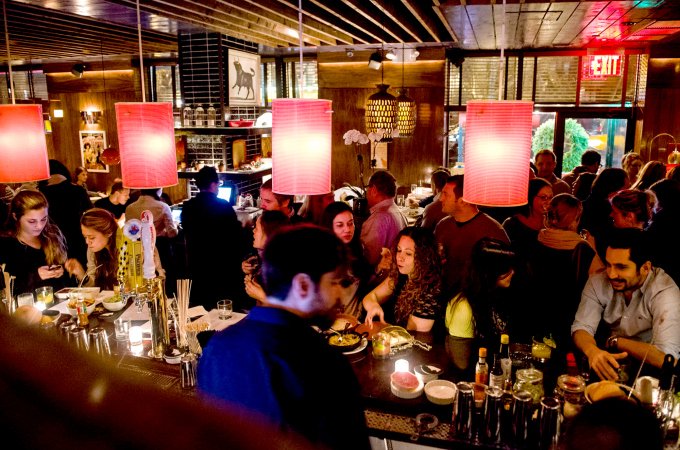Can dining out make you deaf?
 Now ear this: Excruciatingly loud restaurants jeopardize not only your sanity, but your hearing as well.
Now ear this: Excruciatingly loud restaurants jeopardize not only your sanity, but your hearing as well.
Lest you sneer at the pun, leading otolaryngologists — better known as ear, nose and throat specialists — warn that dining at the city’s noisy restaurants can lead to hearing loss.
“I tell my patients to avoid these places. It’s the No. 1 complaint I get as an ear doctor,” says Dr. Darius Kohan, director of otology/neurotology at Lenox Hill Hospital and its affiliated Manhattan Eye, Ear and Throat Hospital.
It’s not just clubby “scene” restaurants, like Tao and Catch, that are dangerously loud. Doctors say anything over 85 decibels — a noise level equivalent to a car or motorcycle passing 30 feet away — can do real damage over time.
Using an iPhone app, I recorded consistent 90-decibel readings during peak hours at three of the city’s hottest new restaurants — the Clocktower, Santina and Lupulo. And long-established, “adult” places aren’t immune. I found similar levels at Lexington Avenue’s Sette Mezzo and Gotham Bar and Grill on East 12th Street.
Not all who complain are old fogeys. Hannah Mattix, a Harlem-based photographer in her 20s, laughs, “My boyfriend and I went to the new Times Square Dos Caminos, where they had a DJ and bare walls. It was so loud it made me miss Times Square gunfire of the old days.”
The risk isn’t to eardrums, but to sensory receptors known as hair cells inside the cochlea, a spiral-shaped cavity in the inner ear that interprets sound.
With repeated, prolonged exposure, “you start losing high-frequency sounds such as women’s and children’s voices,” says Kohan. If damage to the cells advances to a certain point, “a consequence is that you begin to lose hearing,” he says.
Unlike restaurant employees, whose ears take a beating night after night, customers might not even know it’s happening. “For people who go to a loud restaurant for a few hours every Saturday, it will add up, and can lead to hearing loss,” says Kohan. “But it may take them time to realize it. [When] they do notice it, they might think it’s just from age.”
Ear doctors get out just like everyone else, and they have personal observations to go with their clinical ones. “Tao Downtown, oh my God, that was incredibly loud,” noted Dr. Anil K. Lalwani, vice-chair for research in the department of otolaryngology at Columbia University Medical Center.”
Kohan wouldn’t single out any particular culprits, but when he brought up a painfully loud place “with subway tiles,” I said it sounded like the Smith at Lincoln Center — to which he merely chuckled. Not coincidentally, I recorded my loudest reading — a blaring 101 decibels, louder than party-central Tao Downtown and margarita-fueled El Toro Blanco — at the Smith.

NEW YORK – December 8: Pulse – The bar at EL TORO BLANCO, 257 Sixth Ave in Manhattan. December 8, 2012. (Photo by Gabi Porter)
El Toro Blanco’s John McDonald says they’ve taken steps “to improve acoustic quality” by installing “sound panels and more fabrics that help absorb people and music noise,” but my ears didn’t get the email when I popped in around a month ago.
Owners of the other 90-decibel-plus dining dens declined to comment or didn’t get back to us. No surprise: Many want their places to be loud. The din promotes a sense of clubby belonging, which attracts heavy-drinking younger customers and scares off the Olds. Thus, all the closely spaced tables in hard-edged rooms framed by wood floors, bare concrete or brick walls and metal ceilings — plus piped-in music that ratchets up at 10 p.m.
Designer David Rockwell crafted Tao Downtown and another high-volume monster, Bobby Flay’s Gato.
“What helps the sound quality is the barrel-vault brick ceiling,” says Rockwell of Gato’s dining room. “Brick absorbs sounds if it isn’t glazed.”
But, he admits, “The tables are very close together. What starts to happen is, one group starts to talk louder than the next. Then the music turns up, making it louder. This is a trend that should be looked at.”
Or listened to — if anyone can still hear.
This article originally ran on the NY Post here.


